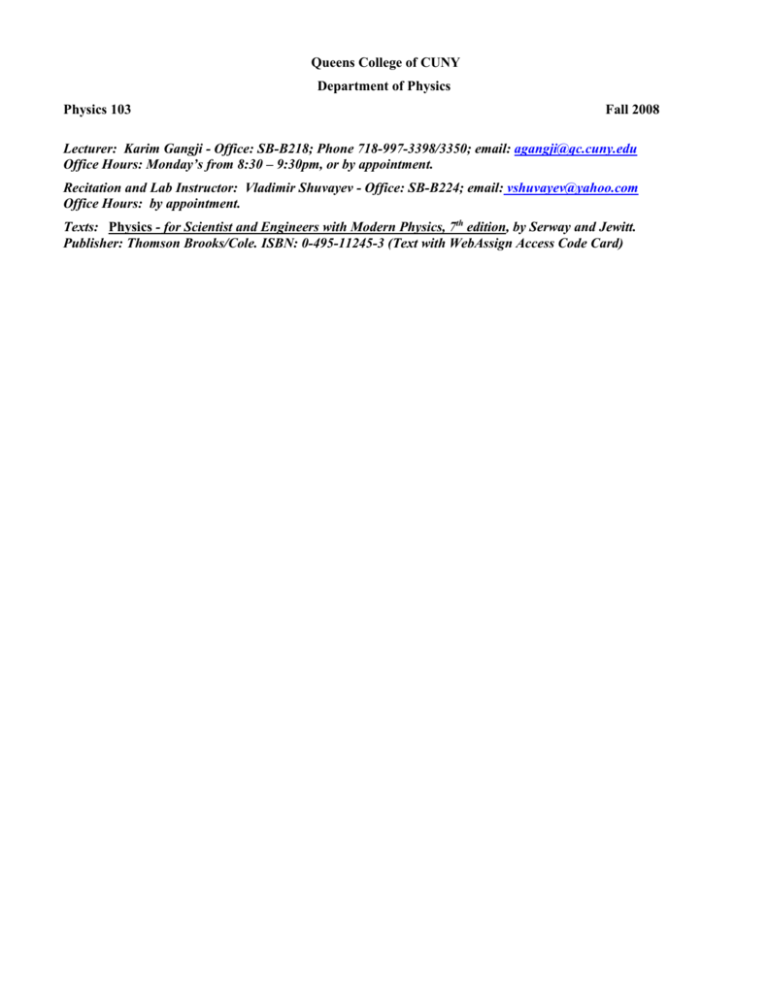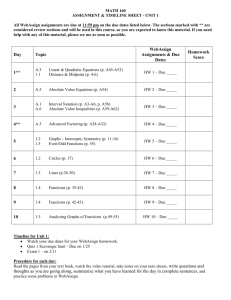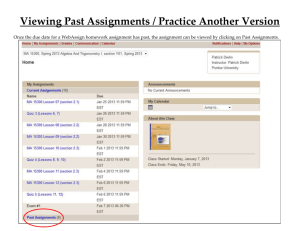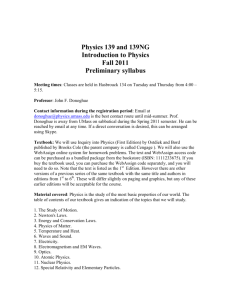QUEENS COLLEGE DEPARTMENT OF PHYSICS
advertisement

Queens College of CUNY Department of Physics Physics 103 Fall 2008 Lecturer: Karim Gangji - Office: SB-B218; Phone 718-997-3398/3350; email: agangji@qc.cuny.edu Office Hours: Monday’s from 8:30 – 9:30pm, or by appointment. Recitation and Lab Instructor: Vladimir Shuvayev - Office: SB-B224; email: vshuvayev@yahoo.com Office Hours: by appointment. Texts: Physics - for Scientist and Engineers with Modern Physics, 7th edition, by Serway and Jewitt. Publisher: Thomson Brooks/Cole. ISBN: 0-495-11245-3 (Text with WebAssign Access Code Card) This is a PLAS course that deals with fundamental principles underlying our understanding of the physical world around us. More specifically the course focuses on the major topics in “classical physics,” the physics developed between the 16th and early 20th centuries. The topics we will cover in class will range from the basic concepts of motion, forces, gravity, energy, electric and magnetic fields, wave motion, etc. To understand these topics, we will take the perspective of a typical physicist and develop methods using mathematics as the language of physics to explain the basic phenomena of the physical universe. You will find out how discoveries in physics not only provided civilization with knowledge, new technologies and devices, but also shaped and changed it. Interaction between students and teaching staff is organized in the form of three components: lectures, recitations and labs. During labs, you will be introduced to and obtain a hands-on experience of empirical methods of scientific inquiry. You will learn to design meaningful scientific experiments, use basic measuring devices and instruments, collect and analyze experimental data in order to make reasonable scientific inferences. In addition to scheduled class times, you will be expected to read a textbook as well as additional reading material, and solve homework problems. Topics in this class include: Mechanics: Kinematics (description of motion); projectile motion in everyday phenomena and in the history of physics; Newton’s laws as the foundation of a mechanical world view and their application in real life; circular motion; Newton’s law of universal gravity and its implications in astronomy, cosmology and space exploration; momentum and its conservation, kinematics of collisions; mechanical energy and its conservation, general concept of energy and its application in physics and beyond. Elements of Wave Motion: Oscillatory motion; simple harmonic oscillator as a universal model of linear oscillations; mechanical waves; the traveling wave model; speed of waves; superposition and standing waves; electromagnetic waves; light as electromagnetic wave; interference of light waves; reflection and transmission. Elements of Electromagnetism: Electric and magnetic fields; electric potential and voltage; current and resistance; Ohm’s law and electric circuits; electric devices. Homework In this course you will use a Web based program (WebAssign) to submit your homework assignments online. You will be able to track your own progress, and have access to all your submitted assignments. The computer will grade your assignments automatically and provide immediate feedback. What it means for you is that you have to be extra cautious entering your numerical answers. Therefore, carefully read the instructions for entering numerical digits. Please note, that different students accessing the same problem will have different numerical values given; therefore, copying someone else’s answer will assure you of an incorrect answer! It is also advisable that you obtain all your answers in symbolic form (algebraic solution) first, and plug in the numerical values only in the final formula. This will help you in case your solution is incorrect and would like to retry your assignment (you can try any given assignment three times). On any given day, only assignments active at that time will be visible; therefore if you miss a deadline for any assignment, you will not be able submit it, resulting in a grade of zero. There will be two types of assignments that you will have to prepare before every class: reading assignments, recitation/online homework problems. Note: Additional problems may be assigned during lectures 1. Reading Assignments: You are to read chapters from your textbook before these chapters will be discussed in the class. I will base the class discussions on the presumption that everybody has read the required material. If you skip the assignment you might have difficulties following the discussion in class. Preparing an outline is a good strategy to master the text. 2. Homework and Recitation Problems: These are problems from the textbook that must be completed using the WebAssign online system. These problems will be graded and counted towards your final grade. Each homework assignment will be available to you only for a limited period of time as indicated on the syllabus and on WebAssign. After the deadline, the homework will be invisible, and a grade of zero will be assigned for missing work. For recitation sessions, a few problems from the textbook that correspond to the online assignment will be selected. Therefore, it is expected that you have at least read and tried the assigned problems to the best of your ability prior to class. Try to solve these problems algebraically as this will enable you to follow and check your solution. Laboratory In order to fulfill the course requirements, it is expected that you will attend and complete all laboratory assignments as directed by your laboratory instructor. Failure to attend laboratory sessions and/or not submitting your laboratory work will result in a failing grade for the course. Exams There will be three exams during the semester. These exams will be given during the lecture/recitation hours. A missed exam will, by default, receive a grade of zero. In case of a documented catastrophic event, such as serious illness, it is your responsibility to discuss the matter with me at the earliest possible time. You will be required to present the final answers for the exam problems in a symbolic form, and only after that plug in the numerical values and obtain numerical answers. The failure to comply with this requirement will result in the loss of points per problem. Use scrap paper for all preliminary calculations. The solution, which you will submit to me, must be presented in a neat form, which must contain all elements of good problem solving. These elements include the following: Given – you should briefly summarize the given data, including whenever possible a sketch visualizing the problem. Basic equations - logically organized chain of formulas leading you to the final equation referred to as a working equation. Solution - the working equation must be clearly presented in terms of the unknown variable followed by the substitution of all numerical values including their units. Answer – clearly box out the numerical answer, make sure you include proper units. Grading The three exams will add up to 60%. The online homework assignment (WebAssign) is worth 15% and your laboratory work is worth 25%. To compensate for the possibility that any of the three exams was either too difficult or fell on a “bad day”, the highest of the three grades will be assigned to a fourth (virtual) exam. Therefore the average examination grade <E>, will be evaluated in the following manner: <E> = (E1+E2+E3+E4)/4 E1, E2, E3 are the grades earned on the three examinations and E4 is the virtual examination grade whose value will be set equal to the highest of the three actual examination grades. The total points earned for the course will be determined according to the following formula Total Points = 0.60×<E> + 0.25×L + 0.15×HW Where L and HW are grades earned for laboratory work and online homework respectively. The letter grade for the course will be assigned, with strict adherence to the Queens College grading policy, based on the earned Total Points. The letter grade for the course will be assigned, according to College Policy, as follows: A = Total Points from 90 to 100 B = Total Points from 80 to 89 C = Total Points from 70 to 79 D = Total Points from 60 to 69 F = Total Points less than 60 Day W Date 08/27 L/R L Lecture (Chapter and Sections) Web Recitation(Questions and Exercises ) Assign Introduction to Ph103 #1 Lab TBA Ch 1: Physics and Measurements(1-6) Ch 2: Motion in One Dimension(1-4) M 09/01 W 09/03 College Closed R Ch 1 P: 4,5,7,9,11,12,16,24,26,31-33,53 Measurements Ch 2 P: 1,3,4,6,8,11,13,15 M 09/08 L Ch 2: Motion in One Dimension(4-8) W 09/10 R Ch 2 : 18,20,22,25,26,28,38,39,44,48,51 M 09/15 L Ch 3: Vectors(1-4) W 09/17 R Ch 3 : 2,4,6,11,12,15,18,19,24,31,34,39,43 M 09/22 L Ch 4: Motion in Two Dimensions(1-5) W 09/24 R Ch 4 : 1,5,8,9,10,15,17,21,23 M 09/29 No Classes Scheduled W 10/01 No Classes Scheduled M 10/06 W 10/08 No Classes Scheduled M 10/13 College Closed *T 10/14 L Ch 5: The Laws of Motion (1-8) W 10/15 R Ch 5: 1,5,9,12,13,16,20,23,26,31,35,37,40,43 M 10/20 L Ch 6 Circular Motion (1) Ex Excel #2 Distance, velocity and acceleration Force Table Exam #1 (Ch 1-4) #3 Measuring g Ch 13 Universal Gravitation (1,2,4) W 10/22 R Ch 6: 1,3,5,7,9 TBA Ch 13: 3,4,9,11,21,24,26 M 10/27 L Ch:7 Energy of a System (1-8) #4 Ch 8 Conservation of Energy (1,2,5) W 10/29 R Ch 7: 1,5,7,10,12,13,15,16,19,29,31,37 Conservation of Energy Ch 8: 3,4,5,7 M 11/03 L/R Ch 9: Linear Momentum (1-4) #5 Ch 9: 1,4,6,7,8,9,11,15,18,19,27,29 W 11/05 Ex M 11/10 L Conservation of Momentum Exam #2 (Ch 5-9,13) Ch 15: Oscillatory Motion (1-4) Ch 16: Wave Motion (1-4) and Ch 34: #6 Electromagnetic Waves(7) W 11/12 R Ch 15: Selected Problems Standing Waves Ch 16: Selected Problems Ch 34: Selected Problems M 11/17 L Ch 18: Superposition and Standing Waves (1-4) #7 Ch 37:Interference of Light Waves (1-4) W 11/19 R Ch 18: Selected Problems Diffraction of Light Ch 37: Selected Problems M 11/24 L Ch 23: Electric Fields (1-7) W 11/26 R Ch 23: Selected Problems M 12/01 L Ch 25: Electric Potential (1-4) and Ch 26: Capacitance (1-4) W 12/03 R Ch 25: Selected Problems #8 Electric Fields Ohm’s Law Ch 26: Selected Problems M 12/08 L Ch 27: Current and Resistance (1,2,4,6) and Ch 28: DC Circuits (1-3) W 12/10 R Ch 27: Selected Problems Ch 28: Selected Problems M 12/15 L/R Ch 29: Magnetic Fields (1-4) Ch 29: Selected Problems ** Ex Exam #3 (Ch 15,16,34,37,23,25-28) #9 DC Circuits




